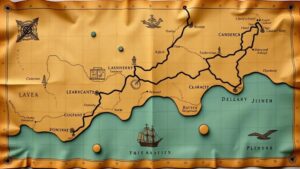Recovering Buried Coins and Relics in Pioneer Trading Posts
Recovering Buried Coins and Relics in Pioneer Trading Posts
Pioneer trading posts played a significant role in the development of commerce and culture in early American history. These establishments served as vital hubs for trade and communication among settlers, indigenous peoples, and various commercial entities. Over time, these sites have become prime locations for treasure hunters and archaeologists alike, who seek to recover buried coins and relics that illuminate the past. This article will explore the methodologies, historical context, and implications of recovering these artifacts.
The Historical Significance of Pioneer Trading Posts
Pioneer trading posts often emerged in the 18th and 19th centuries, serving as focal points for economic exchange in newly settled regions. They provided critical supplies to travelers and goods for trade, fostering interactions across diverse cultural groups. Some of the most notable trading posts include:
- The Santa Fe Trail trading posts, which facilitated commerce between Missouri and New Mexico.
- The Hudson Bay Company posts that linked European traders with indigenous populations in the Pacific Northwest.
These sites are not only rich in history but also in material culture, where various items, from coins to personal belongings, may have been discarded or buried throughout their operational years. Understanding the artifacts recovered from these sites aids historians in reconstructing narratives about life during that era.
Methods for Recovering Buried Artifacts
Effective recovery of buried coins and relics entails a combination of archaeological techniques and modern technology. Key methods include:
- Ground Penetrating Radar (GPR): This non-invasive method uses radar pulses to image the subsurface, providing a visual representation of where artifacts may lie buried.
- Metal Detection: Metal detectors are widely used to locate metallic objects such as coins and tools. They can be especially effective in areas with high soil disturbance.
- Excavation: Once potential sites are identified, controlled excavation based on archaeological principles is critical to recover artifacts systematically.
For example, during excavations at Fort Bridger, Wyoming, a combination of GPR and metal detection led to the discovery of numerous artifacts, including trade beads and coins from various time periods, which provided a clearer picture of the posts trading activities.
Challenges in Recovery Efforts
Despite the promising nature of recovering artifacts from pioneer trading posts, several challenges can impede these efforts:
- Legal Restrictions: Regulations concerning the recovery of artifacts can vary greatly from one region to another. Some places may have stringent laws to protect heritage sites.
- Environmental Conditions: Soil composition, moisture levels, and other environmental factors can affect the preservation of buried relics, influencing their recoverability.
- Public Interest and Ethics: The growing trend of treasure hunting raises ethical concerns about proper stewardship of historical sites. The temptation to keep valuable finds can undermine academic methodologies.
For example, in 2016, the recovery of numerous coins from a historic trading post in Idaho faced backlash as local authorities questioned whether the artifacts would be appropriately preserved or simply sold off to collectors.
The Role of Technology in Artifact Recovery
Advancements in technology have transformed the methodologies employed in recovering buried coins and relics. Techniques such as 3D scanning and photogrammetry allow archaeologists to create detailed representations of artifacts without direct handling. This minimizes damage and provides invaluable data for analysis.
Also, the integration of geographic information systems (GIS) into excavation planning helps in visualizing and mapping excavation sites, facilitating a more organized and systematic approach to artifact recovery.
Case Studies: Notable Discoveries
Several significant finds have underscored the value of recovering artifacts from pioneer trading posts. A notable case is the discovery of a cache of coins in an abandoned trading post in Fairbanks, Alaska, in 2014. The cache included several gold and silver coins dating back to the Klondike Gold Rush, providing insights into the economic landscape of the time. Another example is the excavation at a trading post in Missouri, where archaeologists uncovered tools and personal items that revealed much about the daily lives of traders and indigenous peoples.
Implications for Historical Understanding
The recovery of buried coins and relics from pioneer trading posts has far-reaching implications for our understanding of history. These artifacts serve as tangible links to the past, offering insights into economic practices, cultural exchanges, and daily life in bygone eras. Plus, they contribute to broader narratives about migration, settlement patterns, and the interactions between different cultural groups during America’s formative years.
Actionable Takeaways
For those interested in engaging with the history of pioneer trading posts, whether as amateur historians or budding archaeologists, here are some practical steps:
- Research local regulations regarding the recovery of artifacts in your area.
- Consider joining local historical societies or archaeological organizations to gain insights and collaborate with experts.
- Use technology and tools smartly–invest in quality metal detectors or GPR services when exploring potential sites.
By respecting the history encapsulated in these sites and employing responsible methods for recovery, individuals can contribute to the ongoing dialogue about our shared heritage while uncovering fascinating stories from the past.


